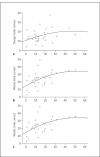Non-Verbal and Verbal Fluency in Prodromal Huntington's Disease
- PMID: 26955384
- PMCID: PMC4777933
- DOI: 10.1159/000441942
Non-Verbal and Verbal Fluency in Prodromal Huntington's Disease
Abstract
Background: This study examines non-verbal (design) and verbal (phonemic and semantic) fluency in prodromal Huntington's disease (HD). An accumulating body of research indicates subtle deficits in cognitive functioning among prodromal mutation carriers for HD.
Methods: Performance was compared between 32 mutation carriers and 38 non-carriers in order to examine the magnitude of impairment across fluency tasks. The predicted years to onset (PYTO) in mutation carriers was calculated by a regression equation and used to divide the group according to whether onset was predicted as less than 12.75 years (HD+CLOSE; n = 16) or greater than 12.75 years (HD+DISTANT; n = 16).
Results: The results indicate that both non-verbal and verbal fluency is sensitive to subtle impairment in prodromal HD. HD+CLOSE group produced fewer items in all assessed fluency tasks compared to non-carriers. HD+DISTANT produced fewer drawings than non-carriers in the non-verbal task. PYTO correlated significantly with all measures of non-verbal and verbal fluency.
Conclusion: The pattern of results indicates that subtle cognitive deficits exist in prodromal HD, and that less structured tasks with high executive demands are the most sensitive in detecting divergence from the normal range of functioning. These selective impairments can be attributed to the early involvement of frontostriatal circuitry and frontal lobes.
Keywords: Cognition; Executive functioning; Neuropsychology; Non-verbal fluency; Phonemic fluency; Prodromal Huntington's disease; Semantic fluency.
Figures



Similar articles
-
Phonemic fluency deficits in asymptomatic gene carriers for Huntington's disease.Neuropsychology. 2008 Sep;22(5):596-605. doi: 10.1037/0894-4105.22.5.596. Neuropsychology. 2008. PMID: 18763879 Clinical Trial.
-
Verbal fluency in Huntington's disease: a longitudinal analysis of phonemic and semantic clustering and switching.Neuropsychologia. 2002;40(8):1277-84. doi: 10.1016/s0028-3932(01)00217-2. Neuropsychologia. 2002. PMID: 11931930
-
Semantic, phonologic, and verb fluency in Huntington's disease.Dement Neuropsychol. 2007 Oct-Dec;1(4):381-385. doi: 10.1590/S1980-57642008DN10400009. Dement Neuropsychol. 2007. PMID: 29213415 Free PMC article.
-
Biological markers of cognition in prodromal Huntington's disease: a review.Brain Cogn. 2011 Nov;77(2):280-91. doi: 10.1016/j.bandc.2011.07.009. Epub 2011 Sep 1. Brain Cogn. 2011. PMID: 21889251 Review.
-
Verbal fluency performance in dementia of the Alzheimer's type: a meta-analysis.Neuropsychologia. 2004;42(9):1212-22. doi: 10.1016/j.neuropsychologia.2004.02.001. Neuropsychologia. 2004. PMID: 15178173 Review.
Cited by
-
Dorsolateral Prefrontal Transcranial Direct Current Stimulation Modulates Language Processing but Does Not Facilitate Overt Second Language Word Production.Front Neurosci. 2018 Jul 25;12:490. doi: 10.3389/fnins.2018.00490. eCollection 2018. Front Neurosci. 2018. PMID: 30090054 Free PMC article.
-
Characterization of visual cognition in pre-manifest, manifest and reduced penetrance Huntington's disease.Sci Rep. 2025 Feb 8;15(1):4707. doi: 10.1038/s41598-025-88406-5. Sci Rep. 2025. PMID: 39922862 Free PMC article.
References
-
- Brandt J, Butters N. The neuropsychology of Huntington's disease. Trends Neurol Sci. 1986;9:118–120.
-
- Beglinger LJ, Nopoulos PC, Jorge RE, Langbehn DR, Mikos AE, Moser DJ, Duff K, Robinson RG, Paulsen JS. White matter volume and cognitive dysfunction in early Huntington's disease. Cogn Behav Neurol. 2005;18:102–107. - PubMed
-
- Bates G, Harper PS, Jones L. Huntington's Disease. ed 3. Oxford: Oxford University Press; 2002.
LinkOut - more resources
Full Text Sources
Other Literature Sources

